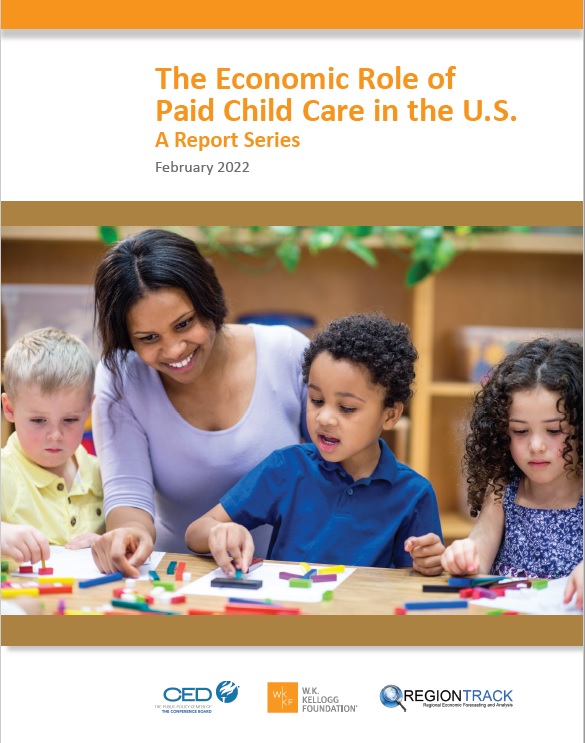
The Economic Impact of Child Care within States

State Child Care Economic Impact Studies
Alabama: Economic Impact of the Early Care and Education Industry on the Economy of the State of Alabama (2013)
Alaska: Economic Impact of Early Care & Learning Services in Alaska (2015 Update)
Arizona: The Economics of Early Care and Education in Arizona (2004)
Arkansas: Estimating the Demand for and Supply of Early Childhood Education in Northwest Arkansas (2016)
California: Economic Impacts of the Child Care Industry (2013)
Economic Impacts of Early Care and Education in California (2011)
California County List of Economic Impact Studies
Colorado: The Economic Impact of Child Care in Colorado (2004)
The Benefits of the Child Care Contribution Tax Credit in Colorado (2011)
Connecticut: The Economic Impact and Profile of Connecticut’s ECE Industry (2004)
Delaware:
District of Columbia: Ensuring a Vibrant City: The Economic Impact of the Early Care and Education Industry in the District of Columbia (2007)
Florida: Economic Impact of Child Care in Florida (2003)
Georgia: Opportunities Lost: How Child Care Challenges Affect Georgia's Workforce & Economy (2018); The Economic Impact of the Early Care and Education Industry in Georgia (2015)
Hawaii: The Economic Impact of the Early Care and Education Industry in Hawaii (2005)
Idaho:
Illinois: Strengthening Illinois Businesses through Investments in Early Care and Education (2014); The Economic Impact of the Early Care and Education Industry in Illinois (2012)
Indiana: Lost Opportunities: The impact of inadequate child care on Indiana's workforce & economy (2018); The Economic Impact of Investing in Early Childhood Education in Indiana (2016)
Iowa: Child Care, Parents & Work: The Economic Role of Child Care in Iowa (2005)
Kansas: A Spatial Analysis of the Formal Child Care Sector in Kansas (2009); The Economic Impact of the Informal Child Care Sector in Kansas (2016)
Kentucky: The economic impact of child care subsidies for Kentucky (2008)
Jefferson and Hardin Counties Kentucky (2004)
Louisiana: Losing Ground: How Child Care Impacts Louisiana's Workforce (2017); Investing in the Child Care Industry: An Economic Development Strategy for Louisiana (2005)
Maine: Strengthening Maine Businesses Through Investments in Early Care & Education (2011)
The Economics of Early Care and Education in Maine (2007)
Maryland: Counting Our Losses: The Hidden Cost to Marylanders of an Inadequate Child Care System (2018)
Massachusetts: The Economic Impact of the Child Care and Early Education Industry in Massachusetts (2004)
Michigan: Strengthening Michigan Businesses through Investments in Early Care and Education (2011)
Minnesota: The Economic Impact of the Child Care Industry in Minnesota (2003)
Mississippi: The Business of Child Care in Mississippi (2003)
Missouri: Strengthening Missouri’s Businesses Through Investments in Early Care and Education (2013)
The Missouri Child Care Industry Economic Impact Report (2005)
Montana: Strengthening Montana Businesses Through Investments in Early Care and Education (2011)
Nebraska: The Economic Impact of the Nebraska Early Care and Education Industry (2007)
Nevada: The Economic Impact of Child Care Subsidies on Labor Force Participation in Nevada (2014); The Economic Impact of Early Care and Education in Nevada (2011)
Parents need child care in order to obtain and retain a job. Children need a safe place to be that promotes their healthy development while their parents are working. The child care industry is an important economic driver within states. In fact, throughout the country, child care has an economic impact of $99.3 billion.
The Committee for Economic Development (CED) released a report, "Child Care in State Economies: 2019 Update" on January 31, 2019. There are 674,332 child care programs (centers and home-based sole proprietors) throughout the United States with revenue of $47.2 billion, employing 1.5 million workers. The spillover impact of these programs (purchases of goods and services) generates an additional $52.1 billion in local economies. With regard to employment, beyond direct jobs within the industry, an additional 507,089 jobs are supported within communities leading to an overall jobs impact of 2 million workers. Find the report, executive summary and state by state fact sheets and talking points on CED's "Child Care Impact" web page. Individual state infographics are posted as well.
New Hampshire: Child Care in New Hampshire: An Economic Impact Report (2009)
New Jersey: Benefits for All: The Economic Impact of the New Jersey Child Care Industry (2006)
New Mexico: The Economic Impact of Early Care and Education in New Mexico (2010)
New York: The Child Care Industry: An Integral Part of Long Island’s Economy (2014); Strengthening New York Businesses through Investments in Early Care and Education (2010)
North Carolina: The Economic Impact of Early Care and Education in North Carolina (2015)
North Dakota: Economic Impact of Child Care in North Dakota (2004)
Ohio: The Economic Impact of the Early Care and Education Industry in Ohio (2004)
Oklahoma: The Economic Role of Oklahoma’s Child Care Industry (2012)
Oregon: The Economic Impact of Oregon’s Child Care Industry (2010)
Pennsylvania: Strengthening Pennsylvania’s Businesses Through Investments in Early Care and Education (2011)
Rhode Island: The Economic Impact of Rhode Island’s Child Care Industry (2003)
South Carolina: The Economic Impact of Early Care and Education in South Carolina (2015); The Economic Impacts of the Child Care Industry in South Carolina (2006)
South Dakota: The Economic Impact of the Child Care Industry in South Dakota (2004)
Tennessee: The Economic Impact of the Child Care Industry in Shelby County, Tennessee (2004)
Texas: Child Care Costs, Wages and Economic Impact (2013); Child Care and Economic Development: The Role for Planners (2006); The Economic Impact of the Child Care Industry in Texas (2003)
Utah: The State of Working Utah (2005)
Vermont: Blue Ribbon Commission on Financing High Quality, Affordable Child Care (2016) Infographic; The Economic Impact of Child Care (2018); Women, Work, and Child Care (2018); Vermont’s Early Care and Learning Dividend (2017)
Virginia: Child Care in the Commercial Corridors: A Report from Arlington Economic Development (2009)
The Economic Impact of the Child Care and Early Education Industry in South Hampton Roads, Virginia (2006)
The Economic Impact of the Child Care Industry in Virginia (2004)
Washington: Child Care is Not Child’s Play (2004)
West Virginia: The Economic Impact of Early Child Development Programs in West Virginia (2005)
Wisconsin: The Economic Benefit of the Child Care Industry in Southeast Wisconsin (2009)
The Economic Impact of Child Care in Milwaukee County (2002)
Wyoming: Wyoming is Paying Greatly for the Lack of Quality Child Care and Early Childhood Education Systems (2009)
Wyoming Kids First: Economic Argument for ECE Investment (2009)
The Economic Impact of the Child Day Care Services Sector on Wyoming’s Economy (2005)

The Economic Role of Paid Child Care in the U.S. Report Series examines the use of paid child care and labor force participation of mothers through a four-part series.
The first report details who uses paid child care, what percent of household income is spent on child care for those families who pay for it, and what characteristics are associated with families who pay for child care (e.g., maternal labor force participation, reported expenditures for child care, household income, level of education, and age of children in paid care) across states.
Read more here. Try the interactive gallery dashboards. CED's web page.
Committee for Economic Development (CED) Paid Child Care Usage Series (2022)
Committee for Economic Development (CED) Child Care in State Economies (2019)


